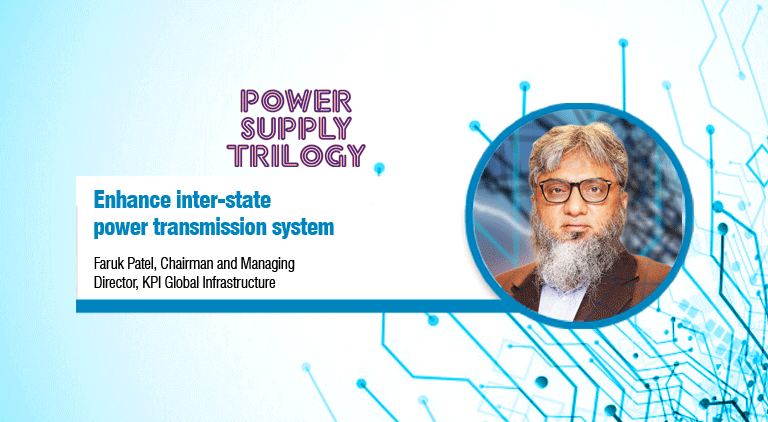Enhance inter-state power transmission system
By EPR Magazine Editorial November 18, 2019 1:49 pm IST
By EPR Magazine Editorial November 18, 2019 1:49 pm IST

Increasing renewable energy capacity without building evacuation infrastructure is like adding vehicle without building roads.
In a discussion about renewable energy with Faruk Patel – Chairman and Managing Director, KPI Global Infrastructure, he mentions about how transmissions are not able to keep up with generation of electricity and what solutions can be used for same.
Moving away from generation and focusing on supply. Your take?
India’s total installed capacity from all sources by end of July 2019 was 360.45 GW, out of this 80.63 Gw is from renewable energy sources. Our country’s present transmission line capacity as on August 2019 is 4537 circuit KM, were as our program target up to year 19-20 is 23621 circuit Km (Sources cea.nic.in). So we can see that there is substantial gap between the generation and supply.
For efficient dispersal of power to deficit regions, strengthening the transmission system network, enhancing the inter-state power transmission system and augmentation of national grid and enhancement of the transmission system network is the need of the hour.
What is the scenario of transmission infrastructure in India?
Increasing renewable energy capacity without building evacuation infrastructure is like adding vehicle without building roads. With the transmission infrastructure unable to keep pace with the increase in solar power generation, the substantial mismatch is bound to put immense pressure on the present transmission infrastructure, a situation which we cannot afford especially when we have huge stakes in the solar power sector.
Our government has understood these needs and has taken step in the form of initiative like the project – Green Energy Corridor. The project includes about approx. 9400 ckm transmission lines and substations of total capacity of approx. 19000 MVA to be completed by March 2020. The purpose is to evacuate approx. 20,000 MW of large scale renewable power and improvement of the grid in the implementing states. More such initiatives, acting as facilitator to developer in ROW issues will play a bigger role in the overall growth of the renewable energy sector.
According to PRAAPTI portal, there has been a rise in the outstanding dues to GENCOs by the DISCOMs. Would this move to focus on supply, will bring any relief to the debts?Despite no publicly declared major incidents of cyber attack in the renewable energy sector to date, successful attacks on the wider energy industry are expected. What are your thoughts on how to curb off such attacks?
The type of risk involved in cyber attack is mainly dangers posed to software and internet connectivity. Since multiple wind and solar farms are now controlled from great distances away from the sites themselves’, control that is often exerted through public IP addresses, which can leave operations, maintenance and monitoring software open to attack.
To avoid cyber attack organization need to follow some good practices
Also, we need to insure under Cyber Risk Policy which covers owners and operators in any circumstance where the ability to generate power – and the associated revenue – is impacted by a cyber attack on proprietary or third-party IT or OT (operational technology) systems is beneficial.
Faruk Patel, Chairman and Managing Director, KPI Global Infrastructure
We use cookies to personalize your experience. By continuing to visit this website you agree to our Terms & Conditions, Privacy Policy and Cookie Policy.